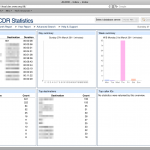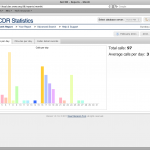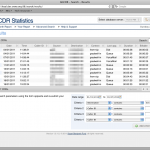Asterisk CDR Statistics
I’ve been a beneficiary of the open source software community for quite some time now. Ever since downloading Slackware Linux onto upteen floppy disks in 1995, I have used and profited from the use of open source software, whether it it be an operating system, programming language, server technology or desktop application. However, up until this point I’ve never given anything back to the open source community (I really don’t count my Twitter CLI script), chiefly because every software system I have created or worked on has been proprietary and subject to non-disclosure agreements. I’m not grumbling about that, not all software is meant to be or should be open source and working on such systems has paid the bills (just about).
So, what have I written? Unhappy about the lack of a decent (and free of charge) system for analysing caller detail records (CDRs) generated by Asterisk PBX telephone systems, I decided that I would combine a number of techniques that I have learnt and developed over the past year or so to put my own package together, and it’s now at the stage where I think it could be considered a beta. This means that it’s not perfect but it’s more or less there. I’ve started hosting it over at Github.
Principal features
- Clean, modern interface.
- Supports multiple Asterisk servers which record their CDRs to a MySQL database.
- Uses Google Chart API to generate dynamic charts.
- Quick and advanced search facilities.
- Rolling monthly and annual reports.
- MVC framework*.
Screenshots
- Main overview
- Month report
- Search results
Further development
Where does it go from here? I’m open to suggestion, which is why I’ve published it and I would welcome comments from anyone who’s interested and/or finds it useful, whether you are a developer or just an end user. Is it useful? Does it work out of the box on your system? Is it easy to install for someone who isn’t a developer? What other features would be useful, bearing in mind that the data produced by the Asterisk CDR MySQL add-on is relatively limited?
I know that the documentation is a little rough around the edges and so I shall be paying attention to that, certainly. I also want to do some really thorough and structured testing in order to ensure it’s as robust as possible. I’ve tested it, obviously, but I’ve not seriously tried to break it yet.
So please feel free to download it, either as a tarball for installation or from the Subversion repository if you would like a good look under the hood. Please submit any comments, suggestions or indeed any code you would like to contribute via the Google Code page in order that all information pertaining to it is kept in the same place. I won’t publish any comments made directly on this blog post for this reason.


